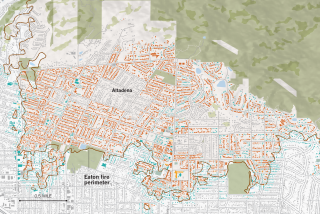How to drive in the rain: A guide for Southern Californians
- Share via
Few Los Angeles stereotypes are as enduring — and at least partially true — as the one about how badly residents drive in the rain.
For those unaccustomed to Southern California’s aggressively sunny climate, it’s hard to understand how even small amounts of rain can cause big problems on the roads. The Times archives are filled with headlines like this one from 1988: “SigAlerts and Clogged Freeways: A Little Rain Spawns Lots of Accidents.”
Many explanations have been offered over the years: grease-slicked roadways, drivers who insist on speeding, ignorance about windshield wiper maintenance. But officials say a few basic practices can help commuters get through.
Turn on headlights
“If your windshield wipers are on, you should have your headlights on,” CHP Officer Juan Galvan said.
Not only do headlights help the driver see potential hazards ahead, they also help other people see the vehicle, Galvan said. Plus, it’s required by the state.
Slow down
“Drive at those speeds that you can maintain control of the car,” Los Angeles Police Department spokesman Drake Madison told The Times. Often that means going below the speed limit.
How can a driver tell how fast is too fast? Don’t outpace the flow of traffic, Madison said, and “if you feel you’re not adhering to the road very well, if you’re slipping and sliding, that’s a clue.”
Also, make sure not to drive so fast that rain collects on the windshield faster than the wipers can clear it away, Galvan said.
Don’t tailgate
It takes longer for vehicles to stop on wet roads, so leave even more distance than usual between your car and the one ahead, Galvan said.
Avoid standing water
“Don’t be the first one to drive through it, and don’t follow another vehicle -- just because they make it doesn’t mean you’re going to make it,” Galvan said.
“Your engine can stall and then you’ll be stuck in there. If it’s a strong current, you might even get swept through that water.”
Plan ahead
Do preventive maintenance to minimize the odds of breaking down and becoming part of an accident, Galvan said. Before heading out in the rain, he said, replace the windshield wiper blades if needed and check the vehicle’s tires and fluids.
Madison said October and November are particularly good months to check wipers and tire treads.
“In the summer months, all the heat is hard on the rubber,” he said.
Pay attention
“Keep your eyes on the road and be aware of your surroundings,” Galvan said. “Accidents are not caused by the rain. It’s how we drive in the rain.”
For news and occasional advice, follow @raablauren on Twitter.
ALSO
How mudslides form after a fire
What’s the difference between a debris flow and a deep-seated landslide?
Dramatic images of 101 Freeway inundated with mud and debris
More to Read
Sign up for Essential California
The most important California stories and recommendations in your inbox every morning.
You may occasionally receive promotional content from the Los Angeles Times.











